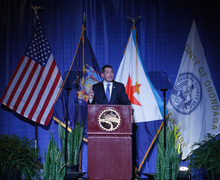King: Animated women lack diversity, trend must not continue
Desk lamp bounces on screen. Crushes “I.”
Every now and again, a post crawls its way out of the pit of Tumblr anonymity and into the harsh light of day. The most recent post to rise was uploaded by the blog EveryFlavorBean, and shows 15 men and 16 women from recent animated movies with their faces traced. The post looked exclusively at Disney and Pixar 3D animated characters. And these tracings have very different results.
The men’s faces differ drastically. Mr. Incredible has a thin sharply pointed nose, while the kid from “Up” sports an adorable little nub. Kristoff from “Frozen” has a very handsome rounded face shape with a honker of a nose, while Wreck-It Ralph’s head looks like a pear.
Meanwhile, on the girls’ side, with recent leads like Elsa and Anna from “Frozen” and Rapunzel from “Tangled,” all of the faces were the same. Round baby face, cute button nose, ginormous eyes. Scary — like an abandoned Bratz doll warehouse.
Obviously, (read: “Frozen”) this face model has worked well for the brand, but every time Pixar stencils in another identical female, it’s another step backward for diverse representation in animation.
Women, as it turns out, can have as many different face types as men. Some women have pointy chins, some have arched noses, some have narrow eyes. So why haven’t we seen them? Lino DiSalvo, who served as “Frozen”’s head of animation and also has worked on movies such as “Tangled” and “Bolt,” was speaking at a roundtable with Fanvoice in 2013 when he shed some light on this phenomenon. “Historically speaking, animating female characters are really, really difficult, ’cause they have to go through these range of emotions… you have to keep them pretty and they’re very sensitive… you can get them off a model very quickly.
Ouch. Disney was quick to have their spokespeople bark at the media for “recklessly” taking his words out of context. But, I mean, the guy said it. It’s hard to believe Pixar is actively making strides to keep their women this way — fetus-looking — but with little evidence to show the contrary, it’s even harder to say they aren’t.
To show men with different features, ranging from the handsome to the homely, but then turn around and slap the same face on every woman is to say that women have to be pretty — ahem — animated pretty, which for most people is impossible. It tells the young women who see these movies that if their faces don’t match, they are somehow made wrong. Although it has gone unchallenged for years, undetected using the guise of family fun, this practice is incredibly sexist and why stop there?
It’s racist too. You can’t just switch around hair and makeup and costumes and call it diversity. Especially if almost all the 3D-animated female leads are white. This isn’t to say that the sample of faces was completely devoid of color. There was also a yellow face, a blue face and green face — each a humanoid representation of emotion in the upcoming movie “Inside Out.” Still, in 2015, no woman of color — you know what I mean — has been given the chance to lead a Pixar film or even be featured in one.
Take a page from DreamWork’s sketchbook. They’re introducing us to the first black female lead to star in a 3D animated movie, “Home.” While she still has the trademark big eyes, button-nose and round face, she’s certainly doing more for diversity than the rainbow aliens Pixar concocted.
Disney and Pixar have a responsibility, especially to young people, to show that the stories of people who look like them matter. This isn’t a coloring book. Besides, I think you’re missing a few crayons.
Eric King is a sophomore magazine journalism major. His column appears weekly. He can be reached at edking@syr.edu and followed on Twitter @erickingdavid.
Published on March 24, 2015 at 12:19 am





